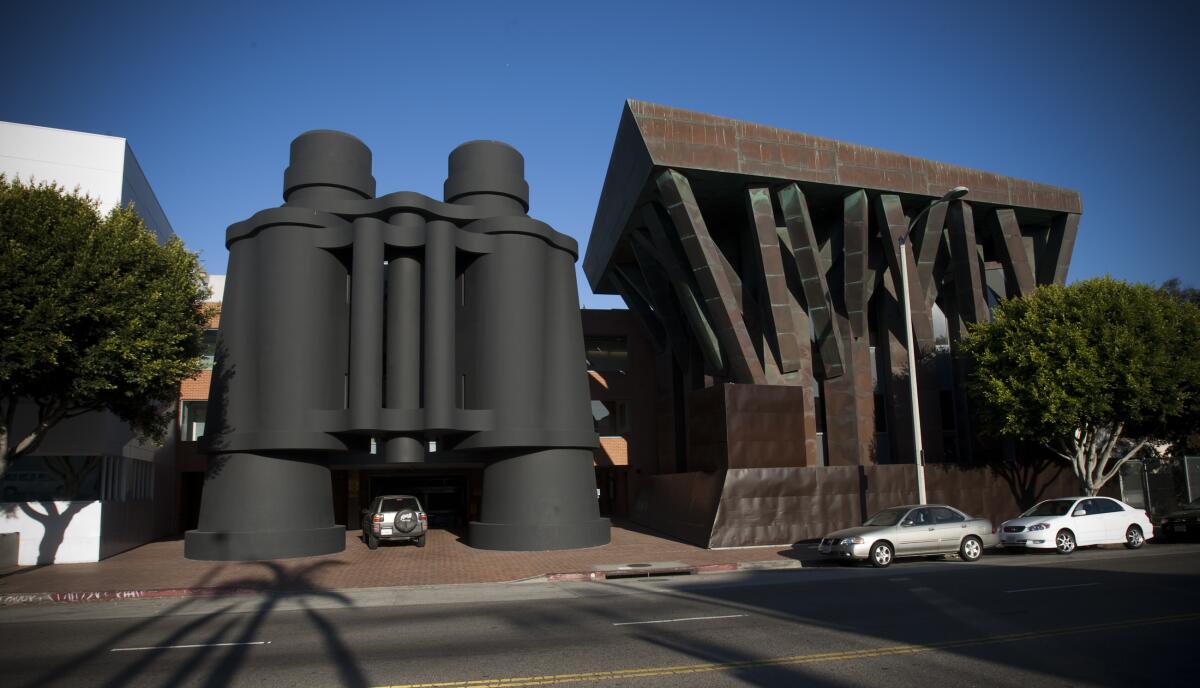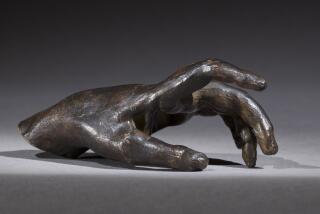Claes Oldenburg, influential Pop artist who made massive sculptures of everyday objects, dies
- Share via
As a Swedish immigrant child in Chicago, Claes Oldenburg dreamed up an imaginary world in intricately detailed drawings. As a founding father of Pop art, he focused on real objects of the most ordinary kind — vacuum cleaners, lipstick tubes, sun hats, typewriter erasers — and re-envisioned them as massive sculptures.
“I am for an art that takes its form from the lines of life itself, that twists and extends and accumulates and spits and drips, and is heavy and coarse and blunt and sweet and stupid as life itself,” he wrote in 1961 in a stream-of-consciousness manifesto. “I am for an artist who vanishes, turning up in a white cap painting signs or hallways.”
A major figure in 20th century art history, Oldenburg died Monday at 93 at his home and studio in New York, said Adriana Elgarresta, a spokeswoman for the Pace gallery in New York, which represented him. He was recovering from a fall, she said.
“I was honored to have this great friendship with one of the most radical artists of the 20th century,” said Arne Glimcher, founder of the Pace gallery. “In addition to his inextricable role in the development of Pop art, he changed the very nature of sculpture from hard to soft, and his influence can be seen to this day.”
Oldenburg was known as a sculptor, draftsman and provocateur throughout his career. In his early days he spoke of creating monuments that would have “an unbridled intense satanic vulgarity unsurpassable, and yet be art.” Some of his efforts were disparaged as oversized art jokes, but he is credited with upending traditional notions about what a monument could be.
Musing on Oldenburg’s towering set of binoculars at the entrance of a building in Venice, Times art critic Christopher Knight concluded: “Binoculars are a man-made tool designed to expand the limits of ordinary human vision—which is a pretty good description of Oldenburg’s monumental sculptures at their best.”
Oldenburg emerged in New York in the late 1950s, when Abstract Expressionism had flamed out and the art world was waiting for the next big thing. For him, it was time to make art that didn’t just sit in a gallery or museum.
Many of his works ended up in top-tier museums, including the Centre Georges Pompidou in Paris and the Tate Gallery in London. But he also left a legacy of public works, mostly made in collaboration with his wife, Dutch art historian Coosje van Bruggen, who died in 2009. Las Vegas has its gigantic “Flashlight”; Philadelphia, its “Clothespin”; Minneapolis, its “Spoonbridge and Cherry”; Chicago, its “Batcolumn” baseball bat; Barcelona, its “Mistos” matchbook.
Oldenburg has had a strong presence in Los Angeles, as well, thanks in part to his friendship with architect Frank Gehry. Plans for an enormous collar and bowtie in front of Gehry’s Disney Concert Hall went awry, but the binoculars distinguish the Gehry building in Venice. “Toppling Ladder with Spilling Paint” adorns the downtown campus of Loyola Law School, amid a collection of Gehry-designed structures.
At the Los Angeles County Museum of Art, Oldenburg’s “Giant Pool Balls” joined the collection in 1969 and his kinetic “Giant Ice Bag” was a star of “Art and Technology,” a landmark exhibition in 1971. Produced by Walt Disney’s WED Enterprises and Gemini G.E.L., a publisher of fine art limited editions, the 18-foot-tall salmon pink sculpture captivated crowds with periodic “dances” on the museum plaza.
At the Museum of Contemporary Art, 16 early Oldenburg sculptures arrived in 1984 as part of a spectacular 80-work purchase from Italian collectors Giuseppe and Giovanna Panza. MOCA is also the home of “Knife/Ship II,” an 83-foot-long sculpture in the shape of a Swiss army knife with motorized blades and a corkscrew.
Oldenburg was born Jan. 28, 1929 in Stockholm, the son of diplomat Gösta Oldenburg and his wife, Sigrid Elisabeth Lindforss. The family moved to the United States in 1936, when Gösta was appointed consul general of Sweden to Chicago.
Claes said that his imaginary world provided a respite from the language barrier encountered in his youth. His younger brother, Richard, also invented a private universe. Both boys periodically retreated into safe places of their own making, where they were free to dream and didn’t have to speak a foreign language to be understood. But they ultimately flourished in their new home and became public figures of considerable note — Claes as an artist and Richard as director of the Museum of Modern Art in New York, from 1972 to 1995.
Claes Oldenburg became a U.S. citizen in 1953, after earning his bachelor’s degree at Yale University and enrolling in night classes at the Art Institute of Chicago. He moved to New York in 1956 and settled on the Lower East Side, where creative energy was bubbling up in gritty surroundings.
In the company of artists such as Red Grooms, Allan Kaprow and Jim Dine, Oldenburg took part in performances called Happenings and scavenged the neighborhood for unconventional art materials.

His first significant exhibitions, in 1959-62, were community enterprises. “The Street,” a scruffy installation inspired by life on the Lower East Side, became a backdrop for Happenings. “The Store,” a mock shop in a rented storefront, was stocked with lumpy, painted plaster versions of everyday goods — tennis shoes, underwear, stockings, cigarettes and food.
Oldenburg married artist Patty Mucha in 1960. A frequent performer in New York Happenings, Mucha sewed many of her husband’s soft sculptures during their 10-year marriage. Unlike the rough-textured plaster works, painted in a slap-dash style, the vinyl and fabric pieces are relatively slick. They often resemble deflated balloons in the shape of home appliances or processed food.
“Shoestring Potatoes Spilling Out of a Bag,” a stuffed canvas work that’s nearly 10 feet tall, is among the Oldenburgs at the Walker Art Center in Minneapolis. “Giant Soft Ketchup Bottle with Ketchup,” an equally lofty soft piece, is at the Norton Simon Museum in Pasadena.
After Oldenburg’s marriage to Van Bruggen, in 1977, some critics had doubts about how the partnership would affect his art. But as years passed, he appeared to have no reservations.
“Her presence in my life has been good for my art,” Oldenburg told The Times in 1995, when a 35-year survey of his work opened at MOCA.
“She’s helped take the work in a direction that’s less self-centered and more lyrical, and I think the work has expanded due to the fact that she and I are opposites: I’m American, she’s European; I’m male and she’s female, and we’re of different generations. We’re both concerned with the senses, however, and our art projects that.”
Oldenburg is survived by a son, daughter and several grandchildren.
Muchnic is a former Times arts writer.
More to Read
Start your day right
Sign up for Essential California for the L.A. Times biggest news, features and recommendations in your inbox six days a week.
You may occasionally receive promotional content from the Los Angeles Times.






